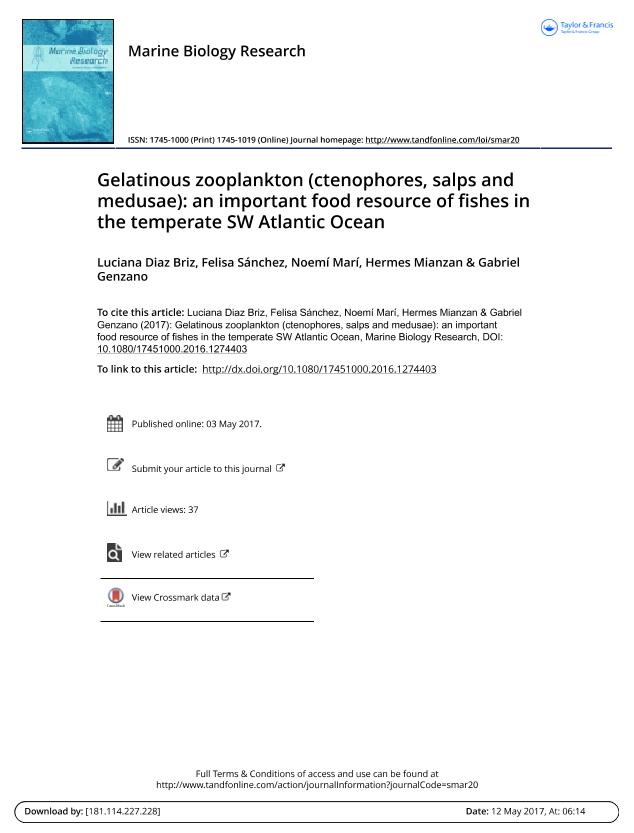Mostrar el registro sencillo del ítem
dc.contributor.author
Diaz Briz, Luciana Mabel

dc.contributor.author
Sánchez, Felisa
dc.contributor.author
Marí, Noemí
dc.contributor.author
Mianzan, Hermes Walter

dc.contributor.author
Genzano, Gabriel Nestor

dc.date.available
2018-11-20T18:29:20Z
dc.date.issued
2017-07
dc.identifier.citation
Diaz Briz, Luciana Mabel; Sánchez, Felisa; Marí, Noemí; Mianzan, Hermes Walter; Genzano, Gabriel Nestor; Gelatinous zooplankton (ctenophores, salps and medusae): an important food resource of fishes in the temperate SW Atlantic Ocean; Taylor & Francis As; Marine Biology Research; 13; 6; 7-2017; 630-644
dc.identifier.issn
1745-1000
dc.identifier.uri
http://hdl.handle.net/11336/64775
dc.description.abstract
This study quantifies the occurrence of gelatinous zooplankton in the stomach contents of fishes from the southwest Atlantic Ocean (33°–55°S). More than 69,000 fish stomachs belonging to 107 species were examined. A total of 39 fishes were documented as consumers of gelatinous zooplankton, 23 of which were newly discovered. Three gelatinous organism consumption categories are recognized: (1) very frequent consumers (10 species, six of which were exclusive); frequent consumers (five species); and occasional consumers (26 species). Three types of gelatinous prey (ctenophores, salps and medusae) were found in the stomach contents of fishes. Ctenophores were consumed at high levels across almost the entire continental shelves of Argentina and Uruguay. Salps were frequent prey on the slope and southern shelf. In contrast, medusae were consumed in coastal areas, slopes and the southern shelf. Classification methods (group average sorting of the Bray–Curtis similarity measures based on log (X + 1)-transformed percentage data) determined six areas where fishes predated on gelatinous organisms. SIMPER (similarity percentages) analysis determined which fishes contributed more to the consumption of gelatinous organisms. Results revealed that two fish species (Stromateus brasiliensis and Squalus acanthias) had high gelatinous zooplankton predation rates throughout the entire study area, while another six species (Patagonotothen ramsayi, Helicolenus dactylopterus lahillei, Macrourus holotrachys, Merluccius hubbsi, Schroederichthys bivius, and Macruronus magellanicus), while widely distributed, seemed to have specific areas where consumption occurred. This study not only provides new knowledge about the importance of gelatinous zooplankton in the diet of numerous fishes, but might also be valuable for planning and managing local fisheries.
dc.format
application/pdf
dc.language.iso
eng
dc.publisher
Taylor & Francis As

dc.rights
info:eu-repo/semantics/openAccess
dc.rights.uri
https://creativecommons.org/licenses/by-nc-sa/2.5/ar/
dc.subject
Consumption Areas
dc.subject
Fish
dc.subject
Gelatinous Plankton
dc.subject
Predation
dc.subject
South Atlantic Ocean
dc.subject.classification
Otras Ciencias Biológicas

dc.subject.classification
Ciencias Biológicas

dc.subject.classification
CIENCIAS NATURALES Y EXACTAS

dc.title
Gelatinous zooplankton (ctenophores, salps and medusae): an important food resource of fishes in the temperate SW Atlantic Ocean
dc.type
info:eu-repo/semantics/article
dc.type
info:ar-repo/semantics/artículo
dc.type
info:eu-repo/semantics/publishedVersion
dc.date.updated
2018-10-23T14:43:53Z
dc.identifier.eissn
1745-1019
dc.journal.volume
13
dc.journal.number
6
dc.journal.pagination
630-644
dc.journal.pais
Reino Unido

dc.journal.ciudad
Londres
dc.description.fil
Fil: Diaz Briz, Luciana Mabel. Consejo Nacional de Investigaciones Científicas y Técnicas. Centro Científico Tecnológico Conicet - Mar del Plata. Instituto de Investigaciones Marinas y Costeras. Universidad Nacional de Mar del Plata. Facultad de Ciencias Exactas y Naturales. Instituto de Investigaciones Marinas y Costeras; Argentina
dc.description.fil
Fil: Sánchez, Felisa. Instituto Nacional de Investigaciones y Desarrollo Pesquero; Argentina
dc.description.fil
Fil: Marí, Noemí. Instituto Nacional de Investigaciones y Desarrollo Pesquero; Argentina
dc.description.fil
Fil: Mianzan, Hermes Walter. Consejo Nacional de Investigaciones Científicas y Técnicas. Centro Científico Tecnológico Conicet - Mar del Plata. Instituto de Investigaciones Marinas y Costeras. Universidad Nacional de Mar del Plata. Facultad de Ciencias Exactas y Naturales. Instituto de Investigaciones Marinas y Costeras; Argentina. Instituto Nacional de Investigaciones y Desarrollo Pesquero; Argentina
dc.description.fil
Fil: Genzano, Gabriel Nestor. Consejo Nacional de Investigaciones Científicas y Técnicas. Centro Científico Tecnológico Conicet - Mar del Plata. Instituto de Investigaciones Marinas y Costeras. Universidad Nacional de Mar del Plata. Facultad de Ciencias Exactas y Naturales. Instituto de Investigaciones Marinas y Costeras; Argentina
dc.journal.title
Marine Biology Research

dc.relation.alternativeid
info:eu-repo/semantics/altIdentifier/doi/https://dx.doi.org/10.1080/17451000.2016.1274403
dc.relation.alternativeid
info:eu-repo/semantics/altIdentifier/url/https://www.tandfonline.com/doi/full/10.1080/17451000.2016.1274403
Archivos asociados
